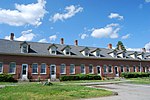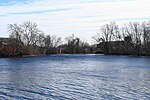Old Killingly High School
1908 establishments in ConnecticutKillingly, ConnecticutNational Register of Historic Places in Windham County, ConnecticutSchool buildings on the National Register of Historic Places in ConnecticutSchools in Windham County, Connecticut

The Old Killingly High School is a historic school building on 185 Broad Street in the Danielson section of Killingly, Connecticut. Built in 1908 and enlarged in 1927, it served as the town's high school until 1965, and then its junior high school until 1990. It is a significant local example of Renaissance and Colonial Revival architecture, designed by Hartwell, Richardson & Driver. It was listed on the National Register of Historic Places in 1992. It now houses the Killingly Police Department.
Excerpt from the Wikipedia article Old Killingly High School (License: CC BY-SA 3.0, Authors, Images).Old Killingly High School
Broad Street,
Geographical coordinates (GPS) Address Nearby Places Show on map
Geographical coordinates (GPS)
| Latitude | Longitude |
|---|---|
| N 41.804 ° | E -71.8803 ° |
Address
Killingly Community Center
Broad Street 185
06239 , Danielson
Connecticut, United States
Open on Google Maps








